Psychological Factors Influencing Conspiracy Theory Acceptance Report
VerifiedAdded on 2021/05/27
|7
|2361
|48
Report
AI Summary
This research report investigates the psychological variables influencing the acceptance of conspiracy theories. The study explores how factors such as extraversion, openness, neuroticism, conscientiousness, agreeableness, and CMQ scores relate to the belief in conspiracy theories. The methodology involves a survey of Australian participants, utilizing scales to measure conspiracist ideation and personality traits. The results reveal correlations between conspiracy beliefs and neuroticism, conscientiousness, and CMQ scores, while rejecting associations with extraversion, openness, and agreeableness. The report discusses the role of psychological parameters, existential motives, and social influences in shaping conspiracy theories, examining the validity of different scales like the CMQ. The findings highlight the complex interplay of psychological factors in the formation and acceptance of conspiracy beliefs, emphasizing the importance of understanding these dynamics within social and cultural contexts.
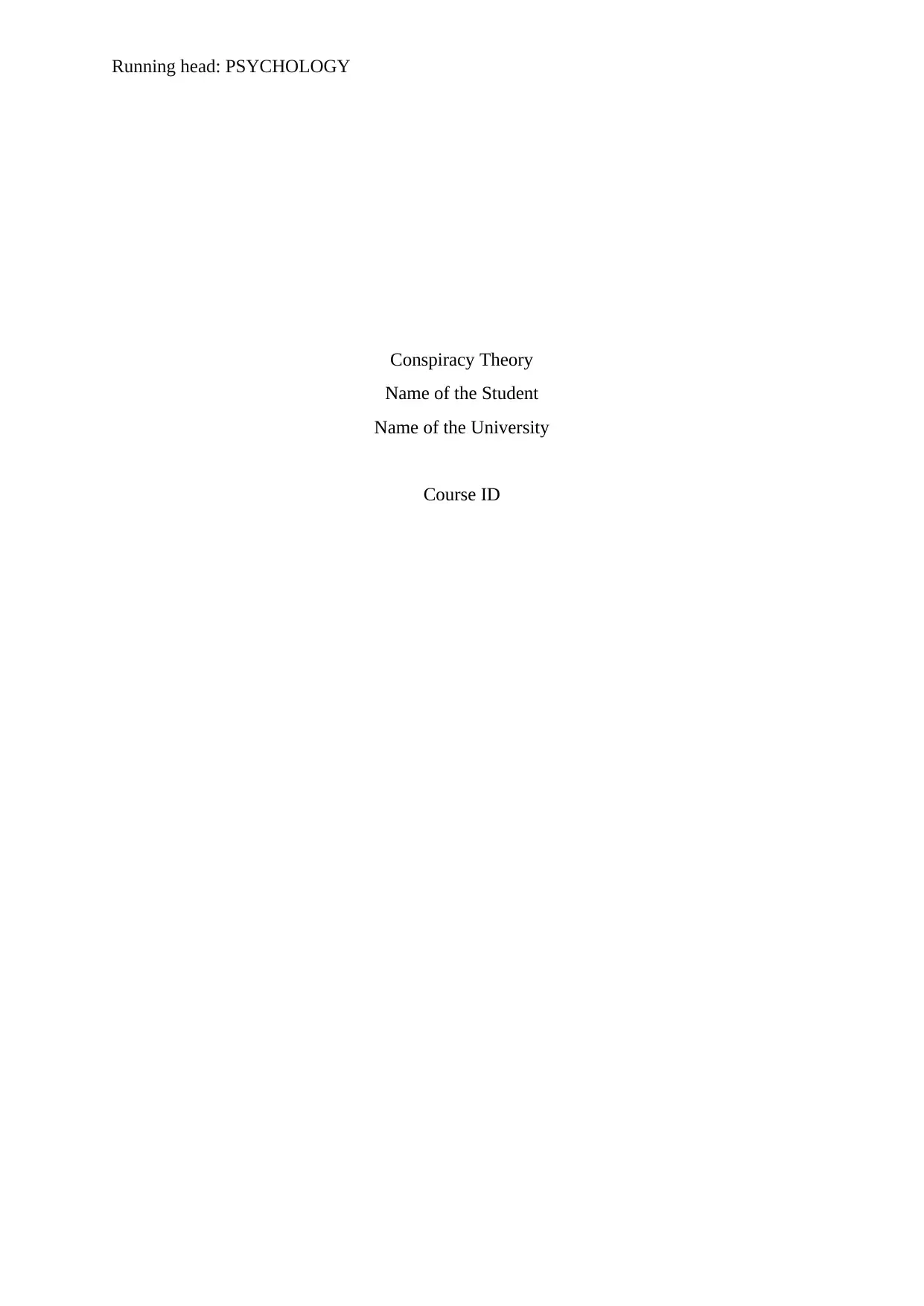
Running head: PSYCHOLOGY
Conspiracy Theory
Name of the Student
Name of the University
Course ID
Conspiracy Theory
Name of the Student
Name of the University
Course ID
Paraphrase This Document
Need a fresh take? Get an instant paraphrase of this document with our AI Paraphraser
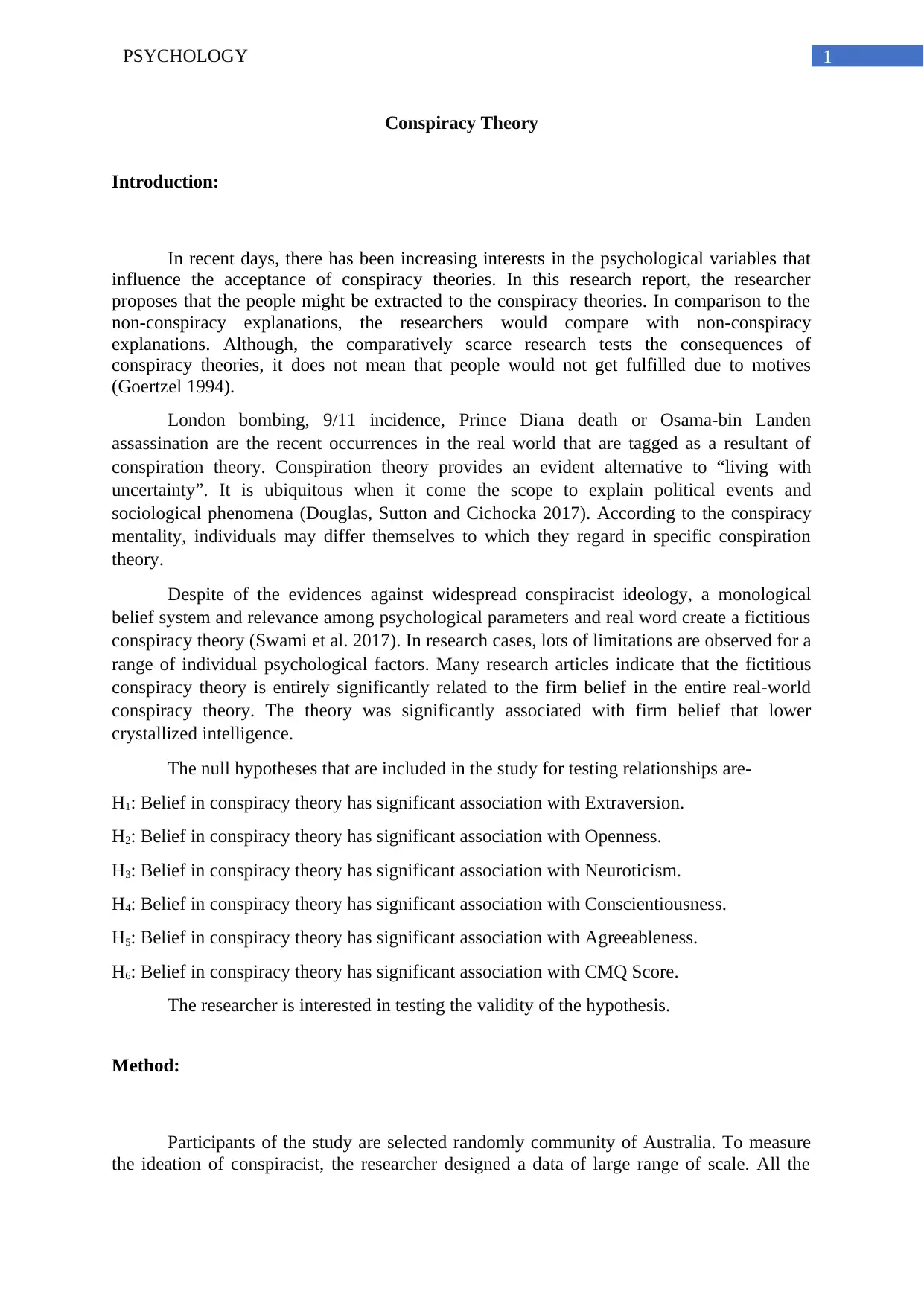
1PSYCHOLOGY
Conspiracy Theory
Introduction:
In recent days, there has been increasing interests in the psychological variables that
influence the acceptance of conspiracy theories. In this research report, the researcher
proposes that the people might be extracted to the conspiracy theories. In comparison to the
non-conspiracy explanations, the researchers would compare with non-conspiracy
explanations. Although, the comparatively scarce research tests the consequences of
conspiracy theories, it does not mean that people would not get fulfilled due to motives
(Goertzel 1994).
London bombing, 9/11 incidence, Prince Diana death or Osama-bin Landen
assassination are the recent occurrences in the real world that are tagged as a resultant of
conspiration theory. Conspiration theory provides an evident alternative to “living with
uncertainty”. It is ubiquitous when it come the scope to explain political events and
sociological phenomena (Douglas, Sutton and Cichocka 2017). According to the conspiracy
mentality, individuals may differ themselves to which they regard in specific conspiration
theory.
Despite of the evidences against widespread conspiracist ideology, a monological
belief system and relevance among psychological parameters and real word create a fictitious
conspiracy theory (Swami et al. 2017). In research cases, lots of limitations are observed for a
range of individual psychological factors. Many research articles indicate that the fictitious
conspiracy theory is entirely significantly related to the firm belief in the entire real-world
conspiracy theory. The theory was significantly associated with firm belief that lower
crystallized intelligence.
The null hypotheses that are included in the study for testing relationships are-
H1: Belief in conspiracy theory has significant association with Extraversion.
H2: Belief in conspiracy theory has significant association with Openness.
H3: Belief in conspiracy theory has significant association with Neuroticism.
H4: Belief in conspiracy theory has significant association with Conscientiousness.
H5: Belief in conspiracy theory has significant association with Agreeableness.
H6: Belief in conspiracy theory has significant association with CMQ Score.
The researcher is interested in testing the validity of the hypothesis.
Method:
Participants of the study are selected randomly community of Australia. To measure
the ideation of conspiracist, the researcher designed a data of large range of scale. All the
Conspiracy Theory
Introduction:
In recent days, there has been increasing interests in the psychological variables that
influence the acceptance of conspiracy theories. In this research report, the researcher
proposes that the people might be extracted to the conspiracy theories. In comparison to the
non-conspiracy explanations, the researchers would compare with non-conspiracy
explanations. Although, the comparatively scarce research tests the consequences of
conspiracy theories, it does not mean that people would not get fulfilled due to motives
(Goertzel 1994).
London bombing, 9/11 incidence, Prince Diana death or Osama-bin Landen
assassination are the recent occurrences in the real world that are tagged as a resultant of
conspiration theory. Conspiration theory provides an evident alternative to “living with
uncertainty”. It is ubiquitous when it come the scope to explain political events and
sociological phenomena (Douglas, Sutton and Cichocka 2017). According to the conspiracy
mentality, individuals may differ themselves to which they regard in specific conspiration
theory.
Despite of the evidences against widespread conspiracist ideology, a monological
belief system and relevance among psychological parameters and real word create a fictitious
conspiracy theory (Swami et al. 2017). In research cases, lots of limitations are observed for a
range of individual psychological factors. Many research articles indicate that the fictitious
conspiracy theory is entirely significantly related to the firm belief in the entire real-world
conspiracy theory. The theory was significantly associated with firm belief that lower
crystallized intelligence.
The null hypotheses that are included in the study for testing relationships are-
H1: Belief in conspiracy theory has significant association with Extraversion.
H2: Belief in conspiracy theory has significant association with Openness.
H3: Belief in conspiracy theory has significant association with Neuroticism.
H4: Belief in conspiracy theory has significant association with Conscientiousness.
H5: Belief in conspiracy theory has significant association with Agreeableness.
H6: Belief in conspiracy theory has significant association with CMQ Score.
The researcher is interested in testing the validity of the hypothesis.
Method:
Participants of the study are selected randomly community of Australia. To measure
the ideation of conspiracist, the researcher designed a data of large range of scale. All the
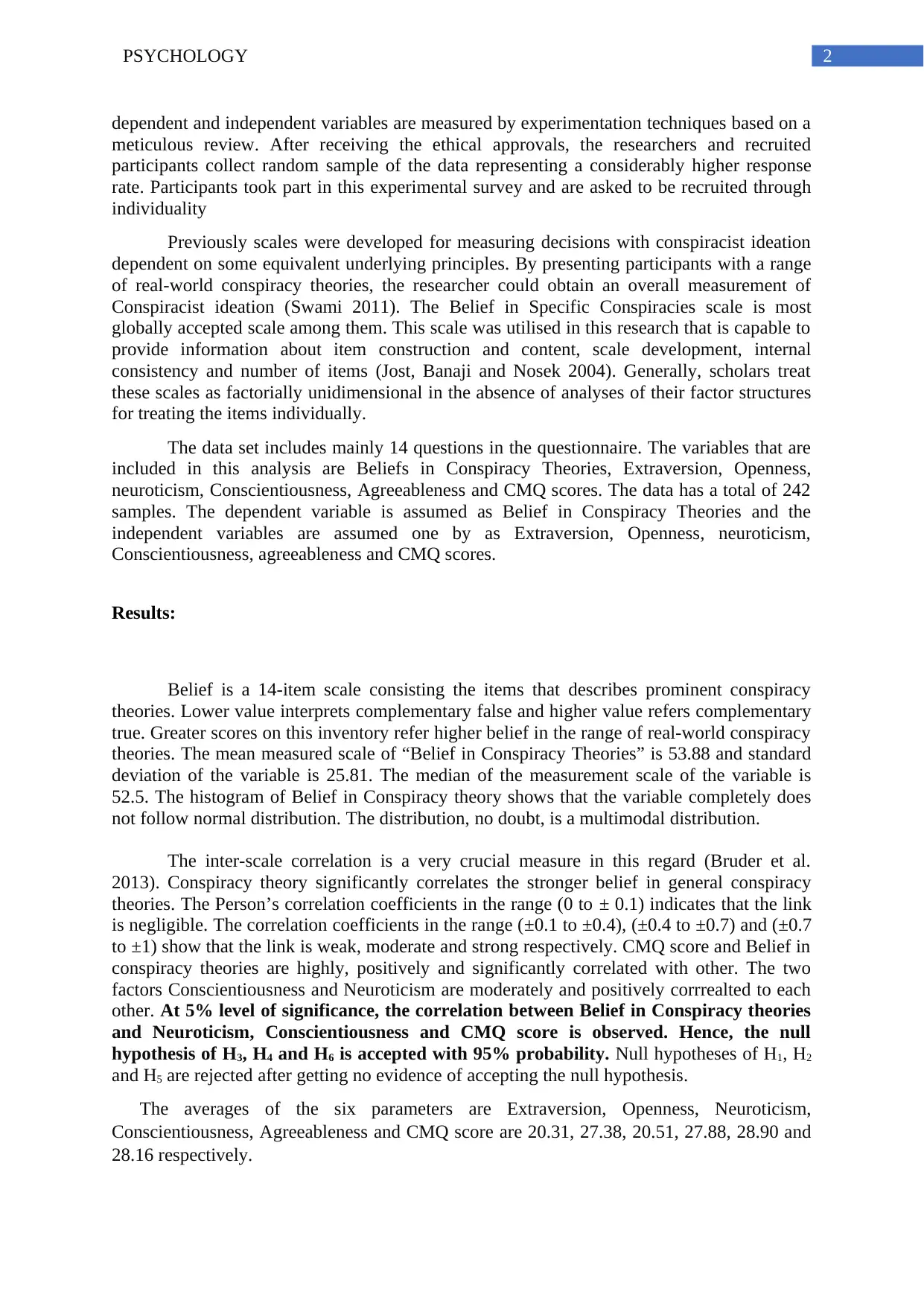
2PSYCHOLOGY
dependent and independent variables are measured by experimentation techniques based on a
meticulous review. After receiving the ethical approvals, the researchers and recruited
participants collect random sample of the data representing a considerably higher response
rate. Participants took part in this experimental survey and are asked to be recruited through
individuality
Previously scales were developed for measuring decisions with conspiracist ideation
dependent on some equivalent underlying principles. By presenting participants with a range
of real-world conspiracy theories, the researcher could obtain an overall measurement of
Conspiracist ideation (Swami 2011). The Belief in Specific Conspiracies scale is most
globally accepted scale among them. This scale was utilised in this research that is capable to
provide information about item construction and content, scale development, internal
consistency and number of items (Jost, Banaji and Nosek 2004). Generally, scholars treat
these scales as factorially unidimensional in the absence of analyses of their factor structures
for treating the items individually.
The data set includes mainly 14 questions in the questionnaire. The variables that are
included in this analysis are Beliefs in Conspiracy Theories, Extraversion, Openness,
neuroticism, Conscientiousness, Agreeableness and CMQ scores. The data has a total of 242
samples. The dependent variable is assumed as Belief in Conspiracy Theories and the
independent variables are assumed one by as Extraversion, Openness, neuroticism,
Conscientiousness, agreeableness and CMQ scores.
Results:
Belief is a 14-item scale consisting the items that describes prominent conspiracy
theories. Lower value interprets complementary false and higher value refers complementary
true. Greater scores on this inventory refer higher belief in the range of real-world conspiracy
theories. The mean measured scale of “Belief in Conspiracy Theories” is 53.88 and standard
deviation of the variable is 25.81. The median of the measurement scale of the variable is
52.5. The histogram of Belief in Conspiracy theory shows that the variable completely does
not follow normal distribution. The distribution, no doubt, is a multimodal distribution.
The inter-scale correlation is a very crucial measure in this regard (Bruder et al.
2013). Conspiracy theory significantly correlates the stronger belief in general conspiracy
theories. The Person’s correlation coefficients in the range (0 to ± 0.1) indicates that the link
is negligible. The correlation coefficients in the range (±0.1 to ±0.4), (±0.4 to ±0.7) and (±0.7
to ±1) show that the link is weak, moderate and strong respectively. CMQ score and Belief in
conspiracy theories are highly, positively and significantly correlated with other. The two
factors Conscientiousness and Neuroticism are moderately and positively corrrealted to each
other. At 5% level of significance, the correlation between Belief in Conspiracy theories
and Neuroticism, Conscientiousness and CMQ score is observed. Hence, the null
hypothesis of H3, H4 and H6 is accepted with 95% probability. Null hypotheses of H1, H2
and H5 are rejected after getting no evidence of accepting the null hypothesis.
The averages of the six parameters are Extraversion, Openness, Neuroticism,
Conscientiousness, Agreeableness and CMQ score are 20.31, 27.38, 20.51, 27.88, 28.90 and
28.16 respectively.
dependent and independent variables are measured by experimentation techniques based on a
meticulous review. After receiving the ethical approvals, the researchers and recruited
participants collect random sample of the data representing a considerably higher response
rate. Participants took part in this experimental survey and are asked to be recruited through
individuality
Previously scales were developed for measuring decisions with conspiracist ideation
dependent on some equivalent underlying principles. By presenting participants with a range
of real-world conspiracy theories, the researcher could obtain an overall measurement of
Conspiracist ideation (Swami 2011). The Belief in Specific Conspiracies scale is most
globally accepted scale among them. This scale was utilised in this research that is capable to
provide information about item construction and content, scale development, internal
consistency and number of items (Jost, Banaji and Nosek 2004). Generally, scholars treat
these scales as factorially unidimensional in the absence of analyses of their factor structures
for treating the items individually.
The data set includes mainly 14 questions in the questionnaire. The variables that are
included in this analysis are Beliefs in Conspiracy Theories, Extraversion, Openness,
neuroticism, Conscientiousness, Agreeableness and CMQ scores. The data has a total of 242
samples. The dependent variable is assumed as Belief in Conspiracy Theories and the
independent variables are assumed one by as Extraversion, Openness, neuroticism,
Conscientiousness, agreeableness and CMQ scores.
Results:
Belief is a 14-item scale consisting the items that describes prominent conspiracy
theories. Lower value interprets complementary false and higher value refers complementary
true. Greater scores on this inventory refer higher belief in the range of real-world conspiracy
theories. The mean measured scale of “Belief in Conspiracy Theories” is 53.88 and standard
deviation of the variable is 25.81. The median of the measurement scale of the variable is
52.5. The histogram of Belief in Conspiracy theory shows that the variable completely does
not follow normal distribution. The distribution, no doubt, is a multimodal distribution.
The inter-scale correlation is a very crucial measure in this regard (Bruder et al.
2013). Conspiracy theory significantly correlates the stronger belief in general conspiracy
theories. The Person’s correlation coefficients in the range (0 to ± 0.1) indicates that the link
is negligible. The correlation coefficients in the range (±0.1 to ±0.4), (±0.4 to ±0.7) and (±0.7
to ±1) show that the link is weak, moderate and strong respectively. CMQ score and Belief in
conspiracy theories are highly, positively and significantly correlated with other. The two
factors Conscientiousness and Neuroticism are moderately and positively corrrealted to each
other. At 5% level of significance, the correlation between Belief in Conspiracy theories
and Neuroticism, Conscientiousness and CMQ score is observed. Hence, the null
hypothesis of H3, H4 and H6 is accepted with 95% probability. Null hypotheses of H1, H2
and H5 are rejected after getting no evidence of accepting the null hypothesis.
The averages of the six parameters are Extraversion, Openness, Neuroticism,
Conscientiousness, Agreeableness and CMQ score are 20.31, 27.38, 20.51, 27.88, 28.90 and
28.16 respectively.
⊘ This is a preview!⊘
Do you want full access?
Subscribe today to unlock all pages.

Trusted by 1+ million students worldwide
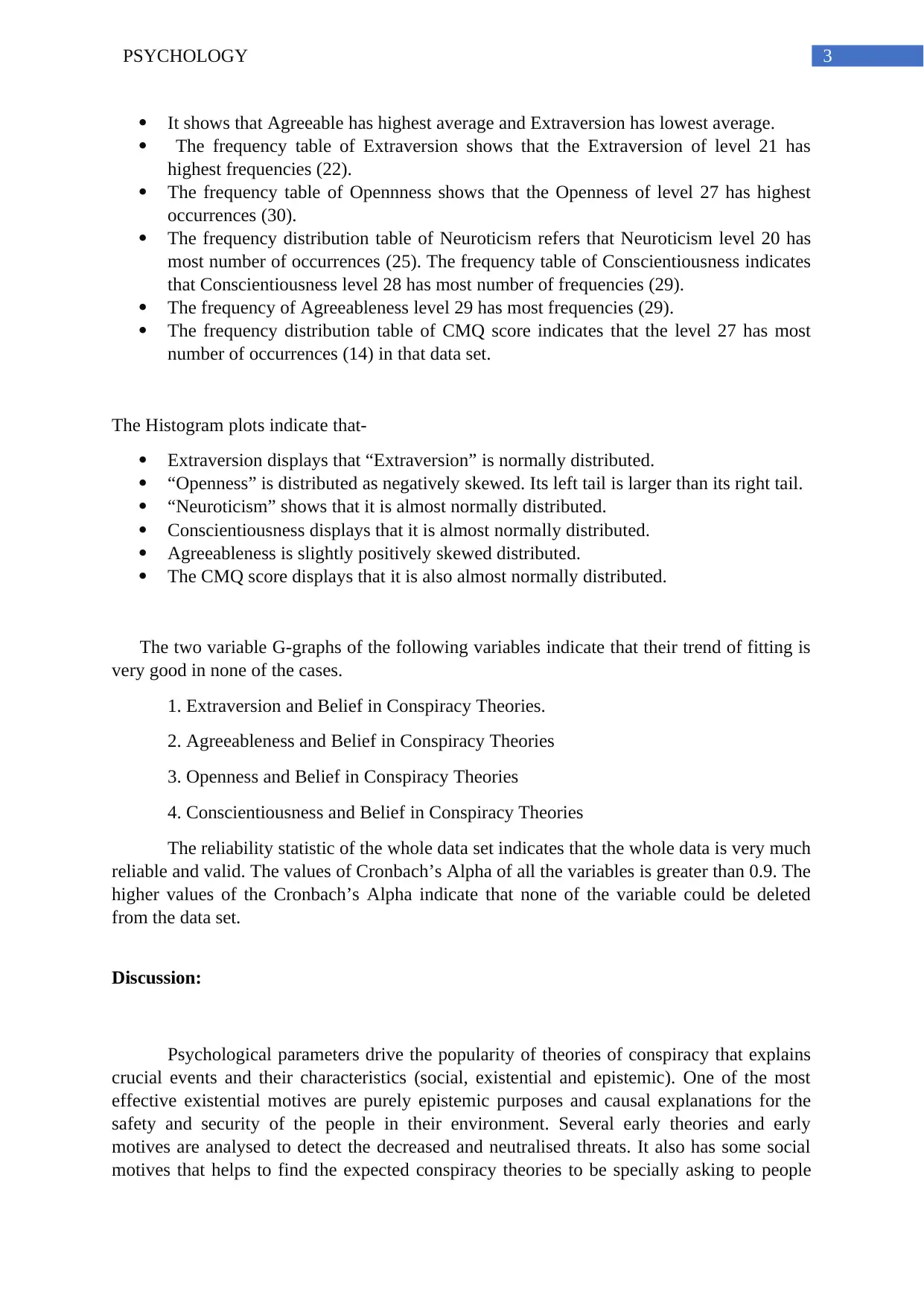
3PSYCHOLOGY
It shows that Agreeable has highest average and Extraversion has lowest average.
The frequency table of Extraversion shows that the Extraversion of level 21 has
highest frequencies (22).
The frequency table of Opennness shows that the Openness of level 27 has highest
occurrences (30).
The frequency distribution table of Neuroticism refers that Neuroticism level 20 has
most number of occurrences (25). The frequency table of Conscientiousness indicates
that Conscientiousness level 28 has most number of frequencies (29).
The frequency of Agreeableness level 29 has most frequencies (29).
The frequency distribution table of CMQ score indicates that the level 27 has most
number of occurrences (14) in that data set.
The Histogram plots indicate that-
Extraversion displays that “Extraversion” is normally distributed.
“Openness” is distributed as negatively skewed. Its left tail is larger than its right tail.
“Neuroticism” shows that it is almost normally distributed.
Conscientiousness displays that it is almost normally distributed.
Agreeableness is slightly positively skewed distributed.
The CMQ score displays that it is also almost normally distributed.
The two variable G-graphs of the following variables indicate that their trend of fitting is
very good in none of the cases.
1. Extraversion and Belief in Conspiracy Theories.
2. Agreeableness and Belief in Conspiracy Theories
3. Openness and Belief in Conspiracy Theories
4. Conscientiousness and Belief in Conspiracy Theories
The reliability statistic of the whole data set indicates that the whole data is very much
reliable and valid. The values of Cronbach’s Alpha of all the variables is greater than 0.9. The
higher values of the Cronbach’s Alpha indicate that none of the variable could be deleted
from the data set.
Discussion:
Psychological parameters drive the popularity of theories of conspiracy that explains
crucial events and their characteristics (social, existential and epistemic). One of the most
effective existential motives are purely epistemic purposes and causal explanations for the
safety and security of the people in their environment. Several early theories and early
motives are analysed to detect the decreased and neutralised threats. It also has some social
motives that helps to find the expected conspiracy theories to be specially asking to people
It shows that Agreeable has highest average and Extraversion has lowest average.
The frequency table of Extraversion shows that the Extraversion of level 21 has
highest frequencies (22).
The frequency table of Opennness shows that the Openness of level 27 has highest
occurrences (30).
The frequency distribution table of Neuroticism refers that Neuroticism level 20 has
most number of occurrences (25). The frequency table of Conscientiousness indicates
that Conscientiousness level 28 has most number of frequencies (29).
The frequency of Agreeableness level 29 has most frequencies (29).
The frequency distribution table of CMQ score indicates that the level 27 has most
number of occurrences (14) in that data set.
The Histogram plots indicate that-
Extraversion displays that “Extraversion” is normally distributed.
“Openness” is distributed as negatively skewed. Its left tail is larger than its right tail.
“Neuroticism” shows that it is almost normally distributed.
Conscientiousness displays that it is almost normally distributed.
Agreeableness is slightly positively skewed distributed.
The CMQ score displays that it is also almost normally distributed.
The two variable G-graphs of the following variables indicate that their trend of fitting is
very good in none of the cases.
1. Extraversion and Belief in Conspiracy Theories.
2. Agreeableness and Belief in Conspiracy Theories
3. Openness and Belief in Conspiracy Theories
4. Conscientiousness and Belief in Conspiracy Theories
The reliability statistic of the whole data set indicates that the whole data is very much
reliable and valid. The values of Cronbach’s Alpha of all the variables is greater than 0.9. The
higher values of the Cronbach’s Alpha indicate that none of the variable could be deleted
from the data set.
Discussion:
Psychological parameters drive the popularity of theories of conspiracy that explains
crucial events and their characteristics (social, existential and epistemic). One of the most
effective existential motives are purely epistemic purposes and causal explanations for the
safety and security of the people in their environment. Several early theories and early
motives are analysed to detect the decreased and neutralised threats. It also has some social
motives that helps to find the expected conspiracy theories to be specially asking to people
Paraphrase This Document
Need a fresh take? Get an instant paraphrase of this document with our AI Paraphraser
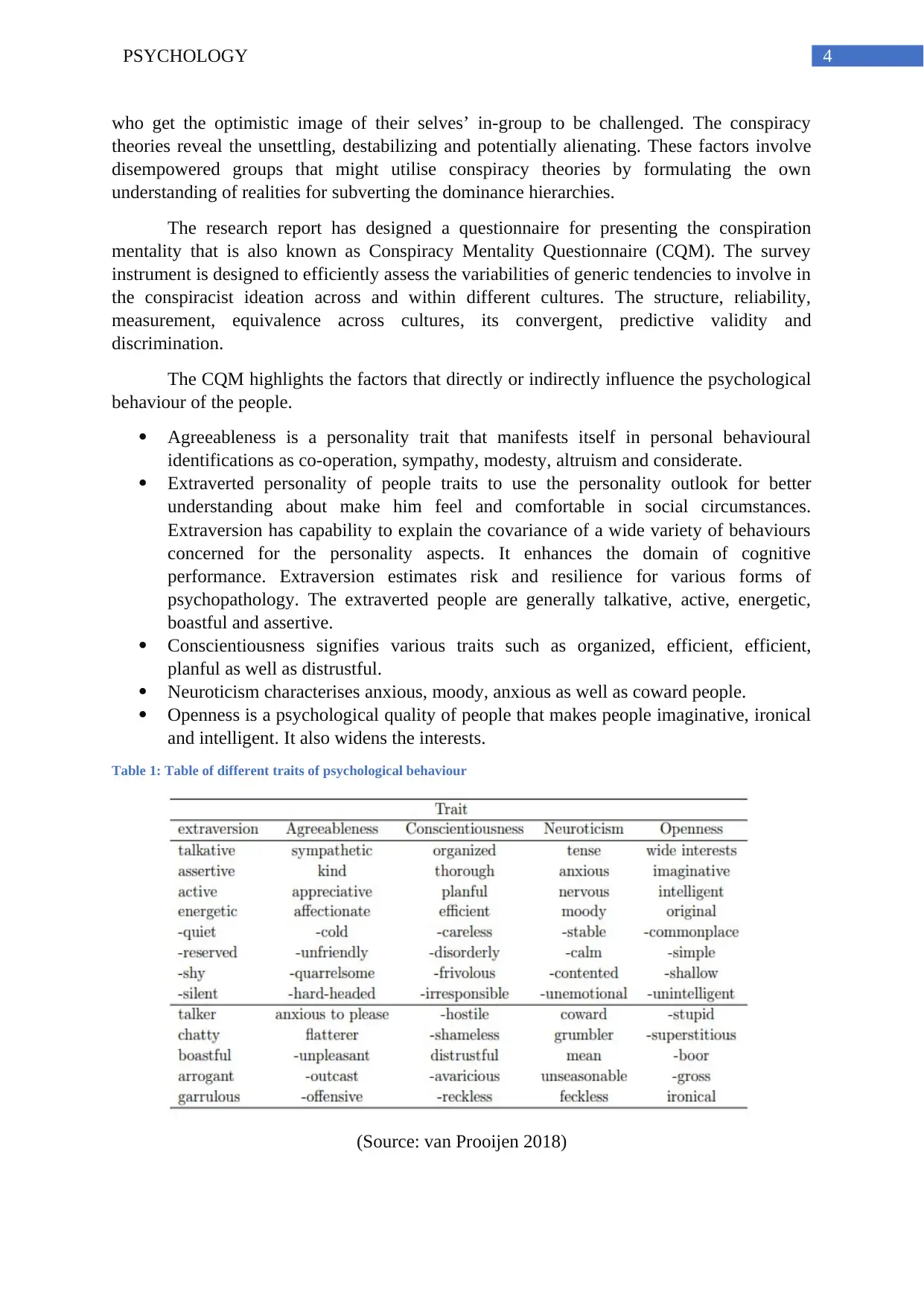
4PSYCHOLOGY
who get the optimistic image of their selves’ in-group to be challenged. The conspiracy
theories reveal the unsettling, destabilizing and potentially alienating. These factors involve
disempowered groups that might utilise conspiracy theories by formulating the own
understanding of realities for subverting the dominance hierarchies.
The research report has designed a questionnaire for presenting the conspiration
mentality that is also known as Conspiracy Mentality Questionnaire (CQM). The survey
instrument is designed to efficiently assess the variabilities of generic tendencies to involve in
the conspiracist ideation across and within different cultures. The structure, reliability,
measurement, equivalence across cultures, its convergent, predictive validity and
discrimination.
The CQM highlights the factors that directly or indirectly influence the psychological
behaviour of the people.
Agreeableness is a personality trait that manifests itself in personal behavioural
identifications as co-operation, sympathy, modesty, altruism and considerate.
Extraverted personality of people traits to use the personality outlook for better
understanding about make him feel and comfortable in social circumstances.
Extraversion has capability to explain the covariance of a wide variety of behaviours
concerned for the personality aspects. It enhances the domain of cognitive
performance. Extraversion estimates risk and resilience for various forms of
psychopathology. The extraverted people are generally talkative, active, energetic,
boastful and assertive.
Conscientiousness signifies various traits such as organized, efficient, efficient,
planful as well as distrustful.
Neuroticism characterises anxious, moody, anxious as well as coward people.
Openness is a psychological quality of people that makes people imaginative, ironical
and intelligent. It also widens the interests.
Table 1: Table of different traits of psychological behaviour
(Source: van Prooijen 2018)
who get the optimistic image of their selves’ in-group to be challenged. The conspiracy
theories reveal the unsettling, destabilizing and potentially alienating. These factors involve
disempowered groups that might utilise conspiracy theories by formulating the own
understanding of realities for subverting the dominance hierarchies.
The research report has designed a questionnaire for presenting the conspiration
mentality that is also known as Conspiracy Mentality Questionnaire (CQM). The survey
instrument is designed to efficiently assess the variabilities of generic tendencies to involve in
the conspiracist ideation across and within different cultures. The structure, reliability,
measurement, equivalence across cultures, its convergent, predictive validity and
discrimination.
The CQM highlights the factors that directly or indirectly influence the psychological
behaviour of the people.
Agreeableness is a personality trait that manifests itself in personal behavioural
identifications as co-operation, sympathy, modesty, altruism and considerate.
Extraverted personality of people traits to use the personality outlook for better
understanding about make him feel and comfortable in social circumstances.
Extraversion has capability to explain the covariance of a wide variety of behaviours
concerned for the personality aspects. It enhances the domain of cognitive
performance. Extraversion estimates risk and resilience for various forms of
psychopathology. The extraverted people are generally talkative, active, energetic,
boastful and assertive.
Conscientiousness signifies various traits such as organized, efficient, efficient,
planful as well as distrustful.
Neuroticism characterises anxious, moody, anxious as well as coward people.
Openness is a psychological quality of people that makes people imaginative, ironical
and intelligent. It also widens the interests.
Table 1: Table of different traits of psychological behaviour
(Source: van Prooijen 2018)
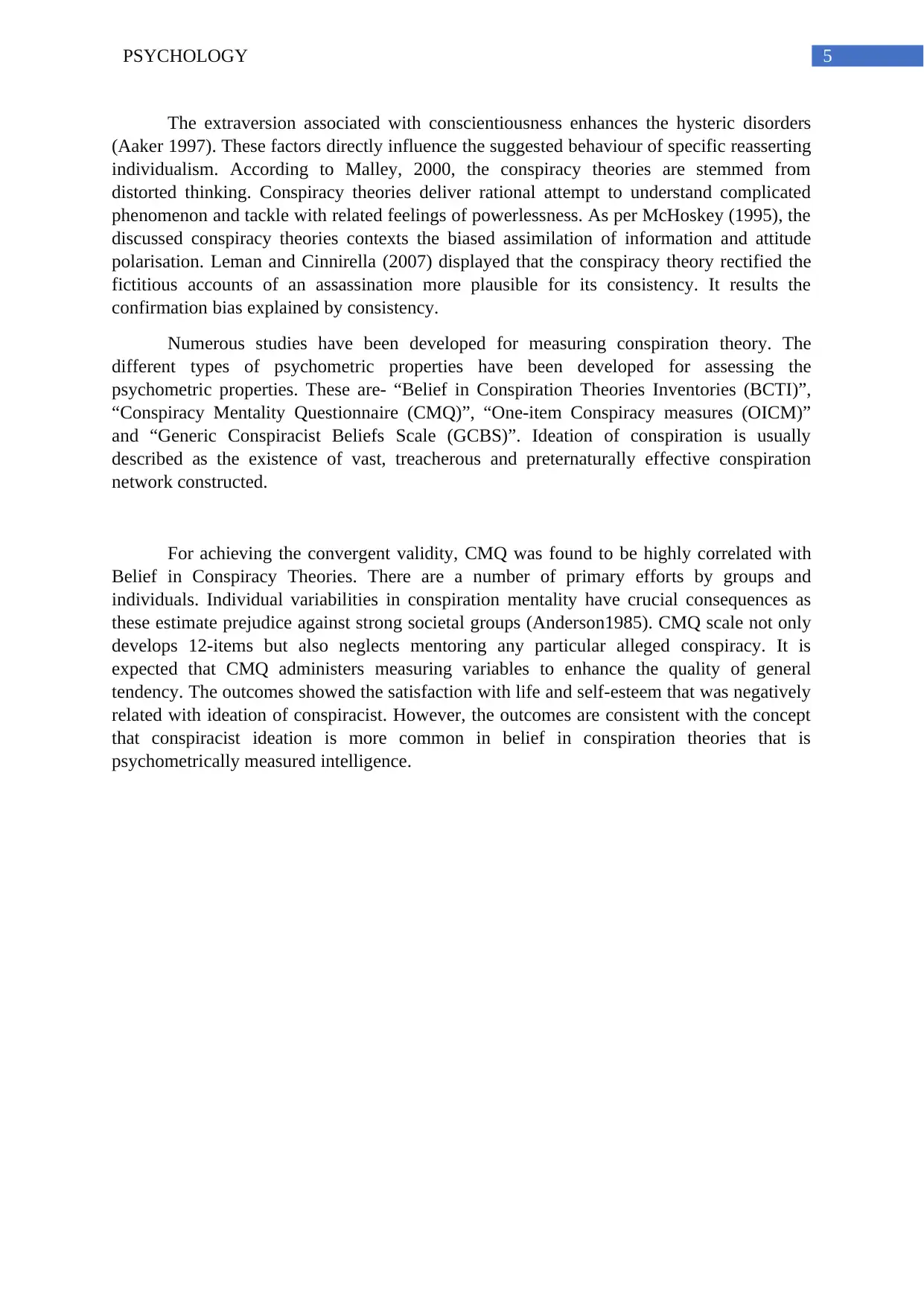
5PSYCHOLOGY
The extraversion associated with conscientiousness enhances the hysteric disorders
(Aaker 1997). These factors directly influence the suggested behaviour of specific reasserting
individualism. According to Malley, 2000, the conspiracy theories are stemmed from
distorted thinking. Conspiracy theories deliver rational attempt to understand complicated
phenomenon and tackle with related feelings of powerlessness. As per McHoskey (1995), the
discussed conspiracy theories contexts the biased assimilation of information and attitude
polarisation. Leman and Cinnirella (2007) displayed that the conspiracy theory rectified the
fictitious accounts of an assassination more plausible for its consistency. It results the
confirmation bias explained by consistency.
Numerous studies have been developed for measuring conspiration theory. The
different types of psychometric properties have been developed for assessing the
psychometric properties. These are- “Belief in Conspiration Theories Inventories (BCTI)”,
“Conspiracy Mentality Questionnaire (CMQ)”, “One-item Conspiracy measures (OICM)”
and “Generic Conspiracist Beliefs Scale (GCBS)”. Ideation of conspiration is usually
described as the existence of vast, treacherous and preternaturally effective conspiration
network constructed.
For achieving the convergent validity, CMQ was found to be highly correlated with
Belief in Conspiracy Theories. There are a number of primary efforts by groups and
individuals. Individual variabilities in conspiration mentality have crucial consequences as
these estimate prejudice against strong societal groups (Anderson1985). CMQ scale not only
develops 12-items but also neglects mentoring any particular alleged conspiracy. It is
expected that CMQ administers measuring variables to enhance the quality of general
tendency. The outcomes showed the satisfaction with life and self-esteem that was negatively
related with ideation of conspiracist. However, the outcomes are consistent with the concept
that conspiracist ideation is more common in belief in conspiration theories that is
psychometrically measured intelligence.
The extraversion associated with conscientiousness enhances the hysteric disorders
(Aaker 1997). These factors directly influence the suggested behaviour of specific reasserting
individualism. According to Malley, 2000, the conspiracy theories are stemmed from
distorted thinking. Conspiracy theories deliver rational attempt to understand complicated
phenomenon and tackle with related feelings of powerlessness. As per McHoskey (1995), the
discussed conspiracy theories contexts the biased assimilation of information and attitude
polarisation. Leman and Cinnirella (2007) displayed that the conspiracy theory rectified the
fictitious accounts of an assassination more plausible for its consistency. It results the
confirmation bias explained by consistency.
Numerous studies have been developed for measuring conspiration theory. The
different types of psychometric properties have been developed for assessing the
psychometric properties. These are- “Belief in Conspiration Theories Inventories (BCTI)”,
“Conspiracy Mentality Questionnaire (CMQ)”, “One-item Conspiracy measures (OICM)”
and “Generic Conspiracist Beliefs Scale (GCBS)”. Ideation of conspiration is usually
described as the existence of vast, treacherous and preternaturally effective conspiration
network constructed.
For achieving the convergent validity, CMQ was found to be highly correlated with
Belief in Conspiracy Theories. There are a number of primary efforts by groups and
individuals. Individual variabilities in conspiration mentality have crucial consequences as
these estimate prejudice against strong societal groups (Anderson1985). CMQ scale not only
develops 12-items but also neglects mentoring any particular alleged conspiracy. It is
expected that CMQ administers measuring variables to enhance the quality of general
tendency. The outcomes showed the satisfaction with life and self-esteem that was negatively
related with ideation of conspiracist. However, the outcomes are consistent with the concept
that conspiracist ideation is more common in belief in conspiration theories that is
psychometrically measured intelligence.
⊘ This is a preview!⊘
Do you want full access?
Subscribe today to unlock all pages.

Trusted by 1+ million students worldwide
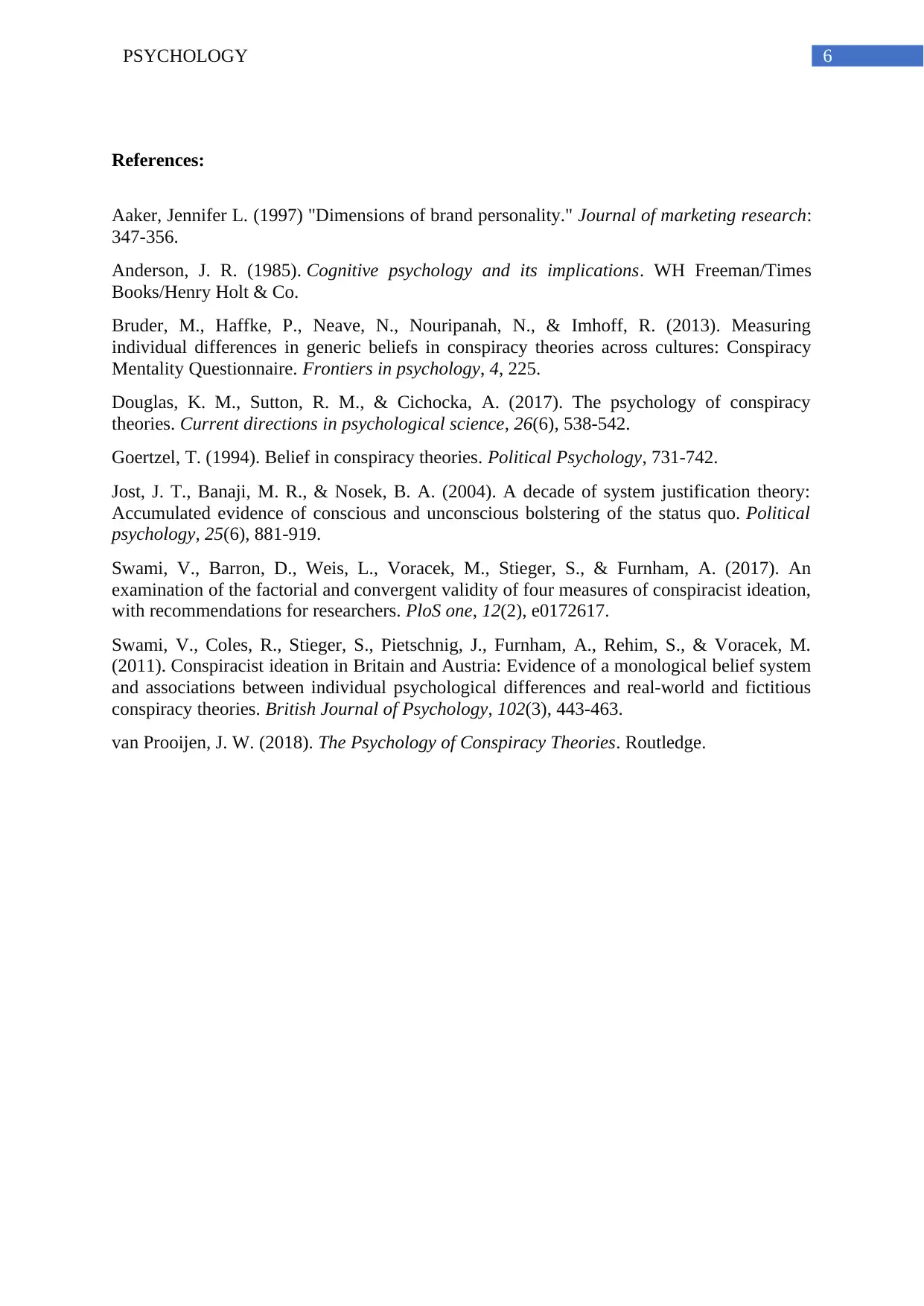
6PSYCHOLOGY
References:
Aaker, Jennifer L. (1997) "Dimensions of brand personality." Journal of marketing research:
347-356.
Anderson, J. R. (1985). Cognitive psychology and its implications. WH Freeman/Times
Books/Henry Holt & Co.
Bruder, M., Haffke, P., Neave, N., Nouripanah, N., & Imhoff, R. (2013). Measuring
individual differences in generic beliefs in conspiracy theories across cultures: Conspiracy
Mentality Questionnaire. Frontiers in psychology, 4, 225.
Douglas, K. M., Sutton, R. M., & Cichocka, A. (2017). The psychology of conspiracy
theories. Current directions in psychological science, 26(6), 538-542.
Goertzel, T. (1994). Belief in conspiracy theories. Political Psychology, 731-742.
Jost, J. T., Banaji, M. R., & Nosek, B. A. (2004). A decade of system justification theory:
Accumulated evidence of conscious and unconscious bolstering of the status quo. Political
psychology, 25(6), 881-919.
Swami, V., Barron, D., Weis, L., Voracek, M., Stieger, S., & Furnham, A. (2017). An
examination of the factorial and convergent validity of four measures of conspiracist ideation,
with recommendations for researchers. PloS one, 12(2), e0172617.
Swami, V., Coles, R., Stieger, S., Pietschnig, J., Furnham, A., Rehim, S., & Voracek, M.
(2011). Conspiracist ideation in Britain and Austria: Evidence of a monological belief system
and associations between individual psychological differences and real‐world and fictitious
conspiracy theories. British Journal of Psychology, 102(3), 443-463.
van Prooijen, J. W. (2018). The Psychology of Conspiracy Theories. Routledge.
References:
Aaker, Jennifer L. (1997) "Dimensions of brand personality." Journal of marketing research:
347-356.
Anderson, J. R. (1985). Cognitive psychology and its implications. WH Freeman/Times
Books/Henry Holt & Co.
Bruder, M., Haffke, P., Neave, N., Nouripanah, N., & Imhoff, R. (2013). Measuring
individual differences in generic beliefs in conspiracy theories across cultures: Conspiracy
Mentality Questionnaire. Frontiers in psychology, 4, 225.
Douglas, K. M., Sutton, R. M., & Cichocka, A. (2017). The psychology of conspiracy
theories. Current directions in psychological science, 26(6), 538-542.
Goertzel, T. (1994). Belief in conspiracy theories. Political Psychology, 731-742.
Jost, J. T., Banaji, M. R., & Nosek, B. A. (2004). A decade of system justification theory:
Accumulated evidence of conscious and unconscious bolstering of the status quo. Political
psychology, 25(6), 881-919.
Swami, V., Barron, D., Weis, L., Voracek, M., Stieger, S., & Furnham, A. (2017). An
examination of the factorial and convergent validity of four measures of conspiracist ideation,
with recommendations for researchers. PloS one, 12(2), e0172617.
Swami, V., Coles, R., Stieger, S., Pietschnig, J., Furnham, A., Rehim, S., & Voracek, M.
(2011). Conspiracist ideation in Britain and Austria: Evidence of a monological belief system
and associations between individual psychological differences and real‐world and fictitious
conspiracy theories. British Journal of Psychology, 102(3), 443-463.
van Prooijen, J. W. (2018). The Psychology of Conspiracy Theories. Routledge.
1 out of 7
Your All-in-One AI-Powered Toolkit for Academic Success.
+13062052269
info@desklib.com
Available 24*7 on WhatsApp / Email
![[object Object]](/_next/static/media/star-bottom.7253800d.svg)
Unlock your academic potential
Copyright © 2020–2025 A2Z Services. All Rights Reserved. Developed and managed by ZUCOL.


